It's A Perennial Affair To Remember
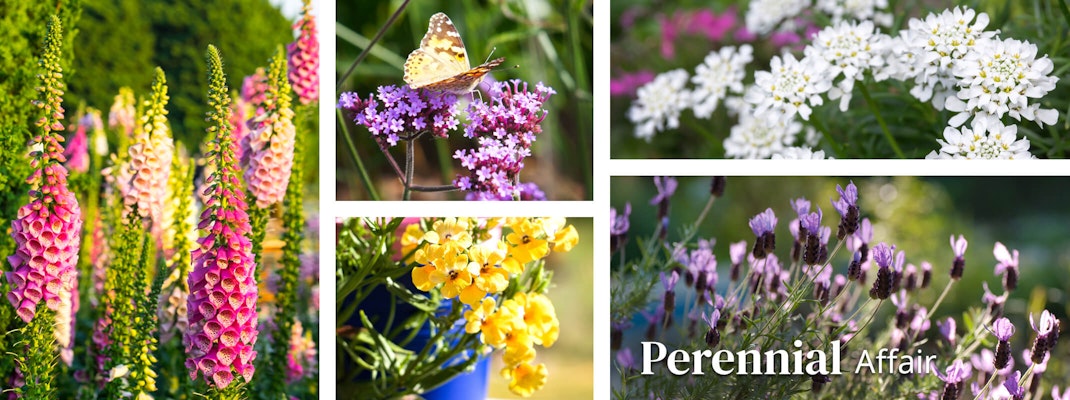
Join us for our Perennial Affair!
We have a beautiful selection to choose from and now is the perfect time to plant perennials that will create delight in your garden for years to come.
Choosing the right perennials for your California landscape may feel like a daunting task so we’ve simplified this process with...
7 Tips to Selecting The Right Perennials:
1. Light requirements are key to your success!

In order to properly select the best plant for a given area of your garden, you must first understand the amount of light that area gets throughout the day and during the growing season. Plant tags will let you know how much light a plant generally requires. We recommend that you observe and note which sections of your garden receive full sun—at different times of both the day and the year.
Full Sun. In general, full sun is defined as having direct sunlight for at least 6 hours during the middle part of the day during the plant’s growing season. Most common perennials grow best in full sun, so there are many varieties available to choose from. Even so, many of these common full sun varieties can withstand some shade—though their blooms may not be as vibrant. Some of our favorite perennials that do great in full sun include many varieties of Lavender, Osteospermum and some varieties of Argyranthemums. Note: if you are gardening in hot or dry regions, most plants, including those categorized as “full sun”, need some protection from the heat of the sun during the hottest part of the day.

Part sun or part shade. If your garden area gets six hours of morning sun or late afternoon/evening sun during the growing season, then it should be considered part sun (or part shade). Because the sun is not as strong in the early part of the day, plants categorized as “full sun” will not receive the amount of sunlight they require to thrive. If you have areas of your garden that receive filtered or partially filtered sun all day, those should also be considered part sun (or part shade) areas. Perennials such as Argyranthemums, Bacopa, Anigozanthos, Kalancho, Carnations and Azaleas thrive in these light conditions.
Full Shade. The garden area on the north side of your home, as well as any areas shaded by a dense canopy of trees should be considered full shade areas. There are many beautiful full shade plants to choose from. Since the amount of shading an area will receive varies by season, it is good to note that winter months will cast a longer shadow than mid-summer months, when the sun is higher in the sky.

2. Water requirements
The same helpful plant tags will also let you know how much water the perennial will need. As a rule of thumb, most plants require ample water until established. Perennials can take up to two years to be fully established. When planting perennials nearby, make sure the plants also have similar water requirements.
3. Hardiness
Everyone wants their plants to thrive—not just survive. With the Internet at your fingertips, it’s easy to find beautiful images of plants you believe will look amazing in your garden. However, it’s important to know which hardiness zone you live in so you can make sure the perennials you choose will survive in that zone. The Bay Area has many micro-climates, so be specific when looking up your zone. If you’re not sure, ask one of SummerWinds Nursery’s knowledgeable Trusted Garden Advisors.
4. Select perennials based on height and scale
It’s important to select plants that fulfill your needs based on their height and scale once they are fully grown. Plant tags will often tell you the full-grown height of a plant, as well as their spread. While many gardeners are tempted to fill in an area they are planting so that it is immediately more pleasing to the eye, it is important to ensure that you don’t overcrowd your perennials. To ensure your perennials thrive, we recommend that you space them based on their full-grown maximum width.
 5. Choosing perennials by color
5. Choosing perennials by color
Pastels. Pastels are often thought of as tranquil. You will often find light pinks, powdery blues, lavenders and peaches among the palette in English-style cottage gardens.
Bright. Bright colors can energize your garden, provide great accents to your garden and often hold up well in the sun. Examples include race-car reds, energetic oranges, dazzling yellows and magenta.
Complementary colors. Remember the color wheel from school? Those that are opposite, or directly across from one another are complementary colors. These colors are high in contrast, such as the famous color combination of green and red, orange and blue or yellow and violet. This juxtaposition creates a sense of energy and vitality.
Harmonious colors. Harmonious colors fall next to one another on the color wheel. For example, red and orange, orange and yellow, and blue and violet. Instead of pops of color that stand out, a harmonious color palette is easy on the eyes and unifying, while still providing more than one color to choose from. A harmonious garden is often a great place to start, if you’re unsure of the exact feel you want to ultimately create in your garden. Check out the color wheel to see if there’s section of color you’re drawn to, to get started. As your confidence grows, you can add splashes of brighter complimentary colors to your garden in key places to create additional interest.
The monochromatic color scheme. Who says you need color to create drama? Some of the most beautiful gardens have been created with a monochromatic color scheme. Within any given single color, you can open up your garden to a world of plants of varying heights, blooms, textures, tints, tones, shades and more—all within the color of your choice!

6. Consider texture
It can be as equally important to choose a perennial that offers complimentary texture in its foliage, as it is to choose a certain color. Whether you desire a large-leafed plant to fill in a space or wispy grass-like foliage, perennials provide a wide selection of textures to choose from.
7. Perennials with a purpose
Not only are many perennials beautiful, they often attract beneficial bees, hummingbirds, butterflies, birds and other pollinators to your garden.
List of plants that attract:
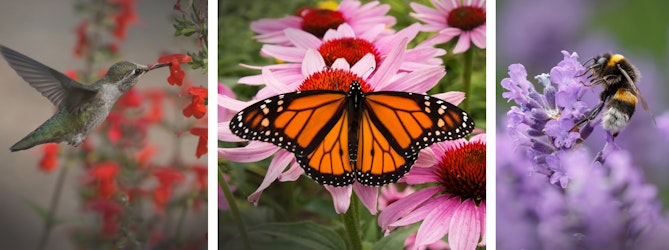
Additional information on perennials
How To Plant Your Perennials Watering Your Perennials Create A Scented PatioGardening Essentials
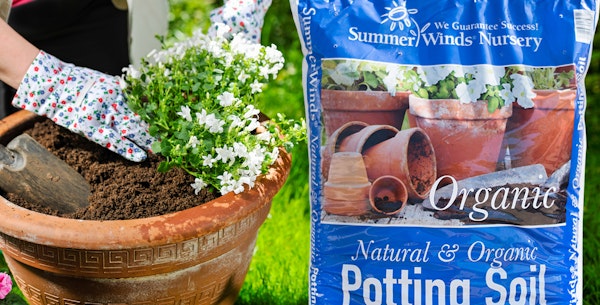
SummerWinds Potting Soil
- Natural and Organic
- Ideal for all types of indoor and outdoor container gardening
- 1.5 cu ft. Bag
E.B. Stone Organics Fertilizers
Choose from these six varieties - Sure Start, All Purpose Plant Food, Tomato and Vegetable Food, Rose & Flower Food, Azalea, Camellia & Gardenia Food, and Citrus & Fruit Tree Food.
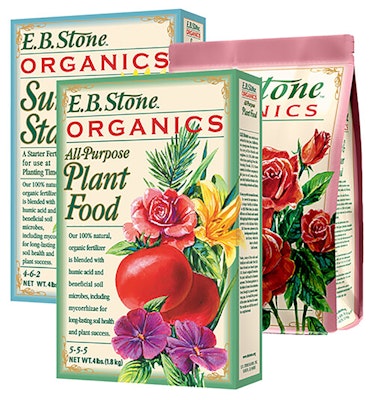 All Purpose is a blend of natural organic ingredients formulated for use throughout the garden. It is suitable for use on vegetables, trees, shrubs, lawns and flower gardens. It is ideal for use when preparing new planting areas and for feeding existing plants. Contains Blood Meal, Feather Meal, Bone Meal, Dried Chicken Manure, Bat Guano, Alfalfa Meal, Kelp Meal, Potassium Sulfate, Humic Acids and soil microbes including mycorrhizal fungi.
All Purpose is a blend of natural organic ingredients formulated for use throughout the garden. It is suitable for use on vegetables, trees, shrubs, lawns and flower gardens. It is ideal for use when preparing new planting areas and for feeding existing plants. Contains Blood Meal, Feather Meal, Bone Meal, Dried Chicken Manure, Bat Guano, Alfalfa Meal, Kelp Meal, Potassium Sulfate, Humic Acids and soil microbes including mycorrhizal fungi.
E.B. Stone Sure Start is a blend of natural organic ingredients formulated to help newly transplanted plants develop strong roots and sturdy growth. Sure Start is rich in natural sources of phosphorus to help your plants develop a strong foundation for future growth. Our gentle and non-burning formula is safe to use with even the most tender transplants. Contains: Blood Meal, Feather Meal, Bone Meal, Dried Chicken Manure, Bat Guano, Alfalfa Meal, Kelp Meal, Potassium Sulfate, Humic Acids and Soil Microbes including Mycorrhizal Fungi.
Rose & Flower FoodE.B. Stone Organics Rose & Flower Food 5-6-3 is suggested for roses, perennials, and other flowering plants. Long lasting, slow-release nitrogen. Registered cdfa.
Tomato & Vegetable FoodE.B. Stone Organics Tomato & Vegetable Food 4-5-3 can be used throughout your vegetable garden, in addition to being used with soft fruits (such as strawberries) to produce high-quality fruits and vegetables. Registered cdfa.
Citrus & Fruit Tree FoodE.B. Stone Organics Citrus & Fruit Tree Food 7-3-3 is ideal for use with citrus trees, fruit trees and other fruit producing plants such as berries. Also good for shade trees, flowering trees, and vines. Registered cdfa. Pair with E.B. Stone Naturals Soil Sulfur.
Azalea, Camellia & Gardenia FoodE.B. Stone Organics Azalea, Camellia & Gardenia Food 5-5-3 is ideal for use with azalea, camellia, and gardenias, as well as other acid-loving plants such as, rhododendrons, fuchsia and evergreen conifers. Registered cdfa.
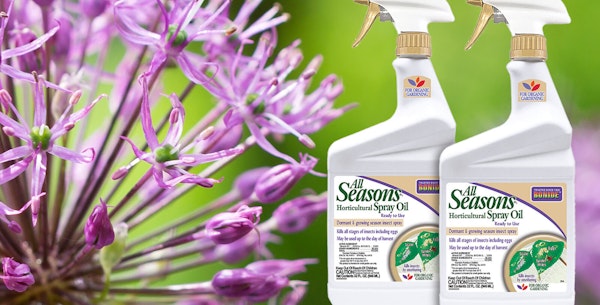
Protect Them with Bonide All Seasons
All Seasons Horticultural Spray Oil kills all stages of insects eggs and may be used up to the day of harvest. For Organic Gardening
We Asked Our Experts...
We asked the experts at each of our locations to give us a list of their favorite perennials.
Campbell SummerWinds Nursery's Perennials of Choice
Some of the perennials chosen by the experts at Campbell come in an array of colors, but we showing how this variety can be done Monochromatically or Harmoniously.

- 1. Salvia - Another versatile perennial that comes in many varieties. This low maintenance sensational bloomer is sure to impress with masses plantings that offer an extended blooming season from spring throughout summer. Hardy, clump-forming, and compact, the fragrant foliage will generally deter grazing deer and rabbits.
- 2. Verbena - This mounding evergreen with deeply divided, green foliage provides months of color with its lovely flowers; nearly year-round in mild climates. A drought tolerant native ideal for borders, natural gardens, and meadows. Beautiful in mixed containers. Available in an assortment of colors. Prefers full sun.
- 3. Lavender - this fragrant perennial comes in many appealing varieties. Requires little water Low once established. This sun lover has a long bloom season. Beautiful as an informal hedge, in low water rock gardens, and in mass plantings along sunny borders. The sweetly aromatic is an excellent source of lavender oil and some varieties are great for culinary use.
- 4. Bacopa - Varieties include extremely large sutera flowers in purples, pinks and white on a well-behaved, trailing plant. Blooms freely through the summer heat. A perfect compliment to combination plantings. An herbaceous perennial in mild winter regions; treat as an annual elsewhere. Prefers Full Sun and does well in borders, containers and edging.
- 5. Million Bells - Calibrachoa come in a vast arrays of colors. This low-maintenance perennial is a great choice for hanging baskets, containers, window boxes and patio containers. No deadheading required for this perennial that offers an exceptional amount of blooms.
Cupertino SummerWinds Nursery's Perennials of Choice
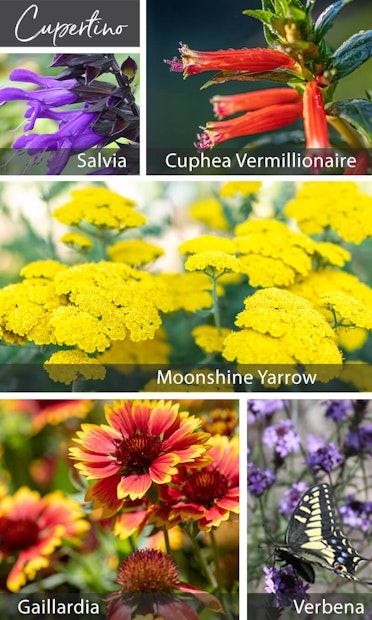
- 1. Friendship Sage - Salvia x 'Amistad'
This exciting new hybrid is a true garden gem, blooming non-stop from early spring until frost. Large, deep royal purple flowers with dark bracts, on dense, vigorous plants. A fine garden or container accent, but stunning when massed in a sunny border. An herbaceous perennial. Quickly reaches 3 to 4 ft. tall, 3 ft. wide. - 2. Cuphea Vermillionaire - This easy to care for perennial attracts butterflies and hummingbirds. Vermillionaire™, like all Cuphea is a heat lover and will do best in warm gardens with bright light. Always keep this plant in full sun for best flowering and to avoid it stretching in the shade. Blooms late spring through fall and is drought tolerant once established. Looks great in borders, containers and mass planting.
- 3. Moonshine Yarrow - Achillea x 'Moonshine'
A fuss-free, heat-loving bloomer with large clusters of canary yellow flowers on narrow stems held well above ferny, grey-green foliage clumps. Use to accent sunny borders and rock gardens, or in mass plantings to create a bold band of color throughout summer. A great cut flower, fresh or dried. An herbaceous perennial. Full sun and blooms in the summer. - 4. Gaillardia - Large, boldly colored, fiery-red flowers edged with a ring of vivid yellow, on a compact, heat and drought tolerant plant. The reliable summer-long blooms make a great impact in landscape or containers. A must-have for sunny beds and borders. Spent flower heads attract goldfinches. An herbaceous perennial. Blooms summer through fall.
- 5. De La Mina Verbena - Verbena lilacina 'De La Mina'
Selected from Cedros Island off the California coast, this mounding evergreen with deeply divided, green foliage provides months of color with its fragrant purple flowers; nearly year-round in mild climates. A drought tolerant native ideal for borders, natural gardens, and meadows. Beautiful in mixed containers. Fast growing; reaches 3 ft. tall and wide. Full Sun and blooms spring through fall.
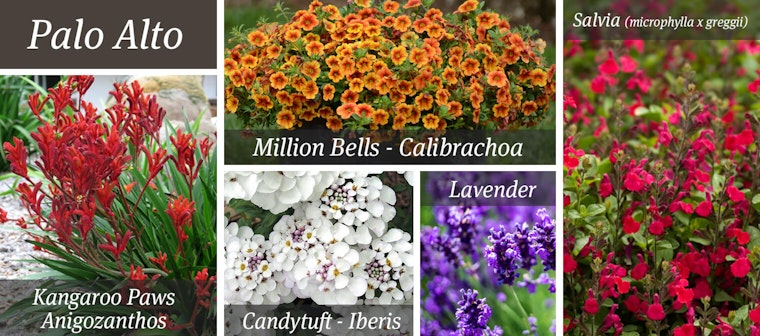
Palo Alto SummerWinds Nursery's Perennials of Choice
- 1. Lavender - this fragrant perennial comes in many appealing varieties. Requires little water Low once established. This sun lover has a long bloom season. Beautiful as an informal hedge, in low water rock gardens, and in mass plantings along sunny borders. The sweetly aromatic is an excellent source of lavender oil and some varieties are great for culinary use.
- 2. Salvia - This aromatic, evergreen shrub produces masses of blooms from spring to fall. Easy to grow, with a compact, rounded habit and exceptional tolerance for dry conditions. Ideal for mixed borders in sunny waterwise gardens, or displayed in patio containers. Evergreen in mild winter regions. Full Sun
- 3. Kangaroo Paws - Anigozanthos
An assortment of colors adorn the unusual paw shaped flowers. Flowers are covered with short hairs and resemble the paws of a kangaroo. The exotic flowers add interest to perennial borders and patio containers in both spring and fall. - 4. Iberis - Glossy, evergreen foliage forms a perfect mound topped by masses of flat clusters of large, pure white flowers. Thrives even in poor soil and drought tolerant once established. Wonderful in borders and mixed containers. Prefers full sun and attracts butterflies.
- 5. Million Bells - Calibrachoa come in a vast arrays of colors. This low-maintenance perennial is a great choice for hanging baskets, containers, window boxes and patio containers. No deadheading required for this perennial that offers an exceptional amount of blooms.

